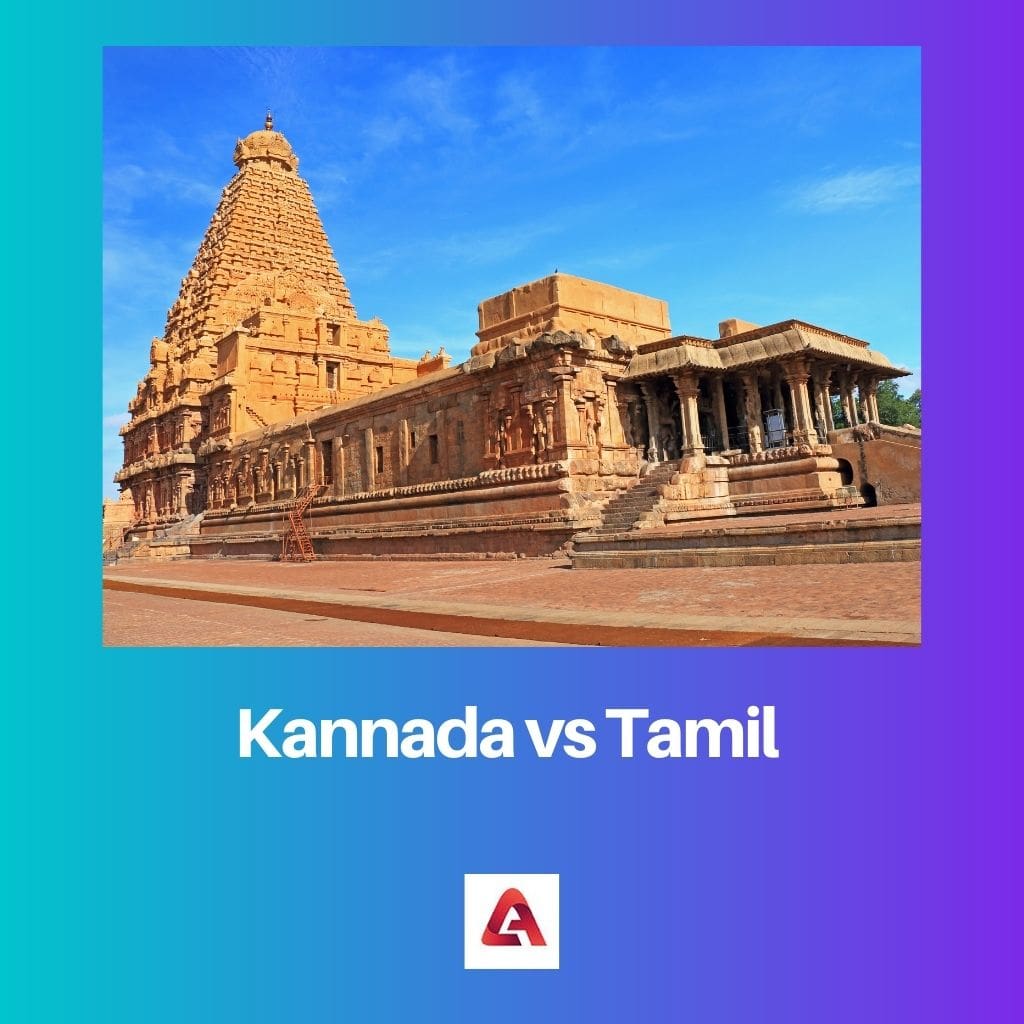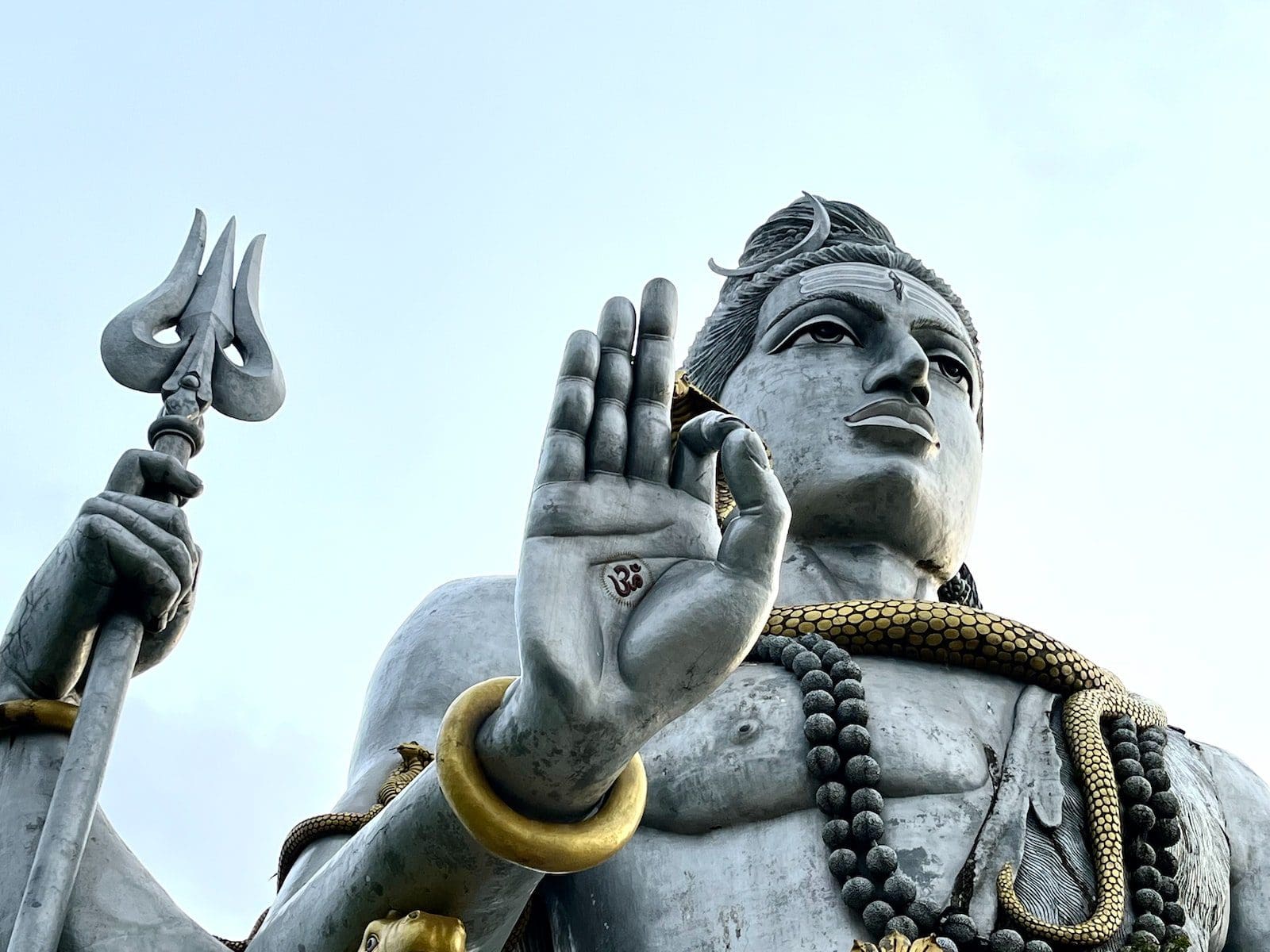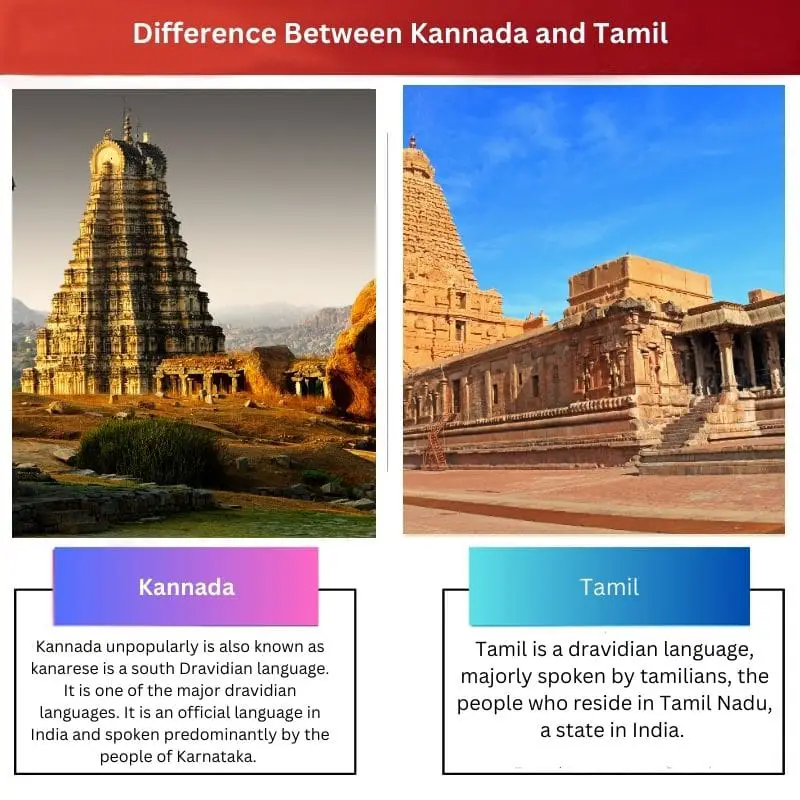Hay 22 idiomas nacionales enumerados en la constitución de la República de la India. India es una de las naciones más diversas del mundo, con más de 1,900 idiomas hablados como lengua materna en India.
Kannada y Tamil son dos idiomas listados oficialmente que descienden del idioma de la familia Dravidian. Como todos los demás idiomas, estos dos idiomas también son únicos en sus respectivas formas y tienen características muy distritales, pero todos los confunden ampliamente.
Puntos clave
- Kannada y Tamil son lenguas dravidianas distintas que se hablan en India; Kannada se habla principalmente en Karnataka, mientras que Tamil se habla en Tamil Nadu.
- La escritura kannada, derivada de la escritura brahmi, tiene formas angulares; La escritura tamil, también derivada de Brahmi, presenta formas redondeadas.
- La literatura kannada y tamil tiene tradiciones únicas, con obras famosas como Jaimini Bharata (kannada) y Silappatikaram (tamil).
Kannada contra tamil
Kannada es un idioma hablado por la gente de Karnataka. 43 millones de personas hablan este idioma. Era una lengua cortesana de los poderosos imperios del pasado. También se considera un idioma clásico de la India. Tamil es un idioma hablado por la gente de Tamil Nadu. Lo hablan 70 millones de personas de todo el mundo. Este idioma fue declarado clásico en la India en 2004.

Kannada es el idioma oficial de la gente de la India en Karnataka. Es una lengua del sur de Dravidian. Es uno de los idiomas más populares de la India y lo hablan casi 43 millones de personas de forma nativa en todo el mundo.
El alfabeto de la escritura Kannada se ha desarrollado a partir de las escrituras Chalukya y Kadamba.
Tamil es también un idioma oficial para la gente de la India en Tamil Nadu. Fue el primer idioma oficial de la India en ser incluido y declarado como idioma clásico por el gobierno de la India.
Tabla de comparación
| Parámetro de comparación | kannada | Tamil |
|---|---|---|
| Etnia | Kannadiga | tamilar |
| Hablado por | 43 millones de personas en todo el mundo | 70 millones de personas en todo el mundo |
| Idioma oficial | Es el idioma oficial de Karnataka. | Es el idioma oficial de Tamil Nadu. |
| Guión | Se originó a partir de la escritura Kannada. | Se originó a partir de la escritura tamil. |
| Influenciado | Está influenciado por los idiomas Pali y Prakrit. | Está influenciado más cerca del malayalam. |
| Personas | Las personas que hablan el idioma kannada se conocen como Kannadigas. | Las personas que hablan el idioma tamil se conocen como tamilians o dravidians. |
¿Qué es Canadá?
Kannada, impopularmente también conocido como Kanarese, es una lengua del sur de Dravidian. Es una de las principales lenguas dravidianas. Es un idioma oficial en la India y lo hablan predominantemente los habitantes de Karnataka.
Aunque también se habla en varios estados de minorías lingüísticas de Maharashtra, Andhra Pradesh, Tamil Nadu, Telengana, Kerala y Goa, las personas que hablan el idioma kannada se conocen como Kannadigas (kannadigaru).
Casi 43 millones de personas hablan kannada de forma nativa. También lo hablan como segundo o tercer idioma más de 12.9 millones de personas, hasta 56.9 millones de hablantes de kannada en todo el mundo.
Kannada anteriormente fue el idioma de la corte de varios imperios poderosos en el sur y el centro de la India: la dinastía Chalukya, la dinastía rashtrakuta, el imperio Vijayanagara y el imperio Hoysala.
El alfabeto del idioma kannada se desarrolló a partir de la escritura kannada, que había evolucionado desde el 5thEscritura kadamba del siglo XIX.
Por recomendación del comité de expertos lingüísticos designado por el Ministerio de Cultura, el gobierno de la India declaró el kannada como el idioma clásico de la India.
La influencia de Prakrit y pail también se puede notar en Kannada. El kannada hablado varía ampliamente de una región a otra, mientras que la forma escrita del kannada es menos consistente en todo Karnataka. Según los informes de etnología, hay casi 20 dialectos de Kannada.

¿Qué es tamil?
El tamil es un idioma dravídico, hablado principalmente por tamiles que residen en Tamil Nadu, un estado de la India. También es el idioma oficial de los estados del sur de la India de Tamil Nadu, junto con Sri Lanka y Singapur.
El tamil es uno de los 22 idiomas incluidos en la constitución de la India. Fue el primero en ser clasificado como un idioma clásico de la India en 2004, y también uno de los idiomas clásicos más longevos del mundo.
Los relatos de la literatura tamil se han documentado durante poco más de 2000 años. La literatura Sangam (período anterior de la literatura tamil) data de ca. 300 a. C. - 3000 d. C. El tamil es parte de la rama sur del idioma dravidiano, una familia de 26 idiomas nativos de los subcontinentes indios.
Malayalam se considera el más cercano al tamil; los dos divergieron alrededor del siglo IX d.C. Entre todas las lenguas indias, el tamil tiene la literatura india no sánscrita más antigua. Según los hindúes leyenda Tamil fue creado por Lord Shiva.

Principales diferencias entre kannada y tamil
- 43 millones de personas hablan el idioma kannada como lengua materna, y como segundo o tercer idioma, 12.9 millones de personas hablan kannada. Al mismo tiempo, el tamil es hablado por 70 millones de personas de forma nativa y como segundo o tercer idioma por 8 millones de personas.
- Kannada es el idioma oficial de Karnataka en India, mientras que Tamil es el idioma oficial de Tamil Nadu, otro estado del sur de India.
- Kannada se originó a partir de la escritura Kannada, y Tamil se originó a partir de la escritura Tamil.
- Pali y Prakrit influyen en el idioma kannada; sin embargo, el idioma tamil está más influenciado por el malayalam.
- Las personas que hablan kannada como lengua materna se denominan kannadigas, mientras que las que hablan tamil como lengua materna, que es una gran proporción, se conocen como tamilianos o dravidianos.

- https://eric.ed.gov/?id=ED184379
- https://www.degruyter.com/downloadpdf/j/ijsl.1978.issue-16/ijsl.1978.16.109/ijsl.1978.16.109.xml
- https://books.google.com/books?hl=en&lr=&id=OQ33i496MsIC&oi=fnd&pg=PA1&dq=tamil&ots=BOHy6_3gtL&sig=_k7F9fzNM9a9jdWj9Sn-oS5ueH4
Última actualización: 11 de junio de 2023


Emma Smith tiene una maestría en inglés de Irvine Valley College. Ha sido periodista desde 2002, escribiendo artículos sobre el idioma inglés, deportes y derecho. Lee más sobre mí en ella página de biografía.

Esta es una exploración impresionante de las distinciones y características de las lenguas kannada y tamil. La tabla comparativa completa es muy informativa.
Absolutamente, el artículo hace un trabajo fantástico al resaltar las características únicas y la historia de ambos idiomas.
Este artículo proporciona una lectura interesante y educativa sobre las tradiciones lingüísticas únicas del kannada y el tamil. La inclusión de la tabla comparativa fue particularmente útil.
Por supuesto, la comparación de idiomas uno al lado del otro es una característica notable de este artículo, lo que lo convierte en un recurso valioso para los entusiastas de los idiomas.
Estoy de acuerdo con su evaluación: la organización del artículo y la profundidad del contenido ofrecen a los lectores una perspectiva integral sobre el kannada y el tamil.
Aprecio los detalles de este artículo, proporciona una comprensión profunda de las diferencias entre kannada y tamil, lo que hace que sea fácil de entender para cualquiera.
Definitivamente, el artículo presenta la información de manera clara y concisa, brindando a los lectores una mirada en profundidad a ambos idiomas.
Aunque este artículo profundiza efectivamente en la singularidad del kannada y el tamil, no aborda la cuestión de la preservación del idioma en la India moderna, que es igualmente importante.
De acuerdo, si bien la comparación es esclarecedora, la importancia contemporánea de estos idiomas sería una valiosa adición a la discusión.
Entiendo su punto, la preservación de estos idiomas es crucial y tal vez una ampliación de este aspecto mejoraría la exhaustividad del artículo.
Este artículo transmite eficazmente las intrincadas diferencias entre kannada y tamil, proporcionando información valiosa sobre los aspectos históricos y lingüísticos de ambos idiomas.
De hecho, la cobertura que hace el artículo de las características distintivas del kannada y el tamil es un ejemplo de investigación y análisis meticulosos y ofrece un estudio encomiable de estos idiomas.
El artículo presenta un análisis encomiable de los aspectos lingüísticos y literarios del kannada y el tamil, subrayando la rica herencia y la influencia de estos idiomas.
Estoy completamente de acuerdo, el enfoque del artículo en las tradiciones únicas del kannada y el tamil es un testimonio del rico entramado cultural e histórico de estos idiomas.
Absolutamente, el examen detallado del artículo de las características del kannada y el tamil proporciona una narrativa cautivadora del profundo significado de estos idiomas.
Este artículo es un retrato ejemplar de las intrincadas distinciones entre kannada y tamil, y refleja la profunda influencia de estos idiomas en la diversa herencia lingüística de la India.
Estoy de acuerdo con su perspectiva: el análisis meticuloso del artículo sobre el kannada y el tamil subraya la importancia perdurable de estos idiomas en la configuración de la rica narrativa cultural e histórica de la India.
Absolutamente, el examen meticuloso del artículo de las tradiciones lingüísticas y literarias del kannada y el tamil ilumina el tapiz multifacético del legado lingüístico de la India.
Este artículo es una enriquecedora fuente de conocimiento sobre la diversidad lingüística en la India, enfatizando los distintos elementos que definen la herencia y evolución de cada lengua.
Estoy de acuerdo con su evaluación, los intrincados detalles discutidos en el artículo brindan una comprensión profunda de las dimensiones lingüísticas y culturales de ambos idiomas.
Por supuesto, la aclaración exhaustiva del artículo sobre las características del kannada y el tamil ofrece a los lectores una exploración profunda de la riqueza lingüística de la India.
El artículo capta admirablemente la esencia del kannada y el tamil, revelando la diversa herencia cultural y literaria que distingue a estos idiomas como facetas integrales del medio lingüístico de la India.
Por supuesto, el análisis exhaustivo del artículo arroja luz sobre las características lingüísticas y literarias matizadas del kannada y el tamil, y ofrece una narrativa convincente del panorama lingüístico pluralista de la India.
De hecho, la exploración exhaustiva que hace el artículo de las tradiciones lingüísticas del kannada y el tamil subraya la importancia de estas lenguas dentro del tejido cultural más amplio de la India.
El contexto histórico del kannada y el tamil es fascinante y este artículo hace un gran trabajo al analizar las complejidades de cada idioma.
Absolutamente, la profundidad de la información proporcionada es encomiable, ya que permite a los lectores obtener información valiosa sobre la herencia lingüística de estas lenguas.